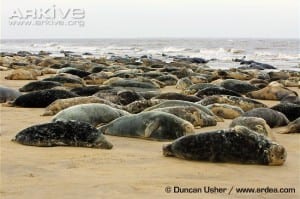What’s the difference between seals and sea lions?
By Jack Ashby, on 26 December 2013
This is one of the easier spots in our “What’s the difference” series, but also one of the most commonly erred of all the picked nits. Zoologists are a pedantic bunch, and whilst correcting people just to demonstrate that you know more than them is not an effective engagement model, the world would be a better place* if more people landed on the right side of the seal vs sea lion dichotomy. The difference is, after all, at the same taxonomic level as otters and red pandas, and few would confuse them.
Seals vs Sea lions: The taxonomy of seal-ish things
All of these things are pinnipeds – a sub-group of the order Carnivora. Pinnipeds are split into three families – True Seals (Phocidae); Eared Seals (Otariidae) and the Walrus (the sole member of Odobenidae).
Let’s dispatch with walruses – they are easy to spot with their tusks.
True seals are the animals that look most like overweight tubes of toothpaste – all of the species we get around the UK are true seals (except for the occasional walrus). Grey seals, leopard seals, elephant seals, harp seals and ringed seals are among the 19 species of true seals.
Eared seals are the 16 species that are commonly named sea lions – because of the males’ manes- and fur seals – because of their dense underfur (for which they were heavily persecuted).
Only true seals are “seals”. Eared seals are not seals; they just look a lot like them.
The two easiest characteristics to look out for when trying to work out whether an animal is a true seal or an eared seal (I expect you can guess what one of them is) are…
Q: Can it walk? (more…)
 Close
Close



